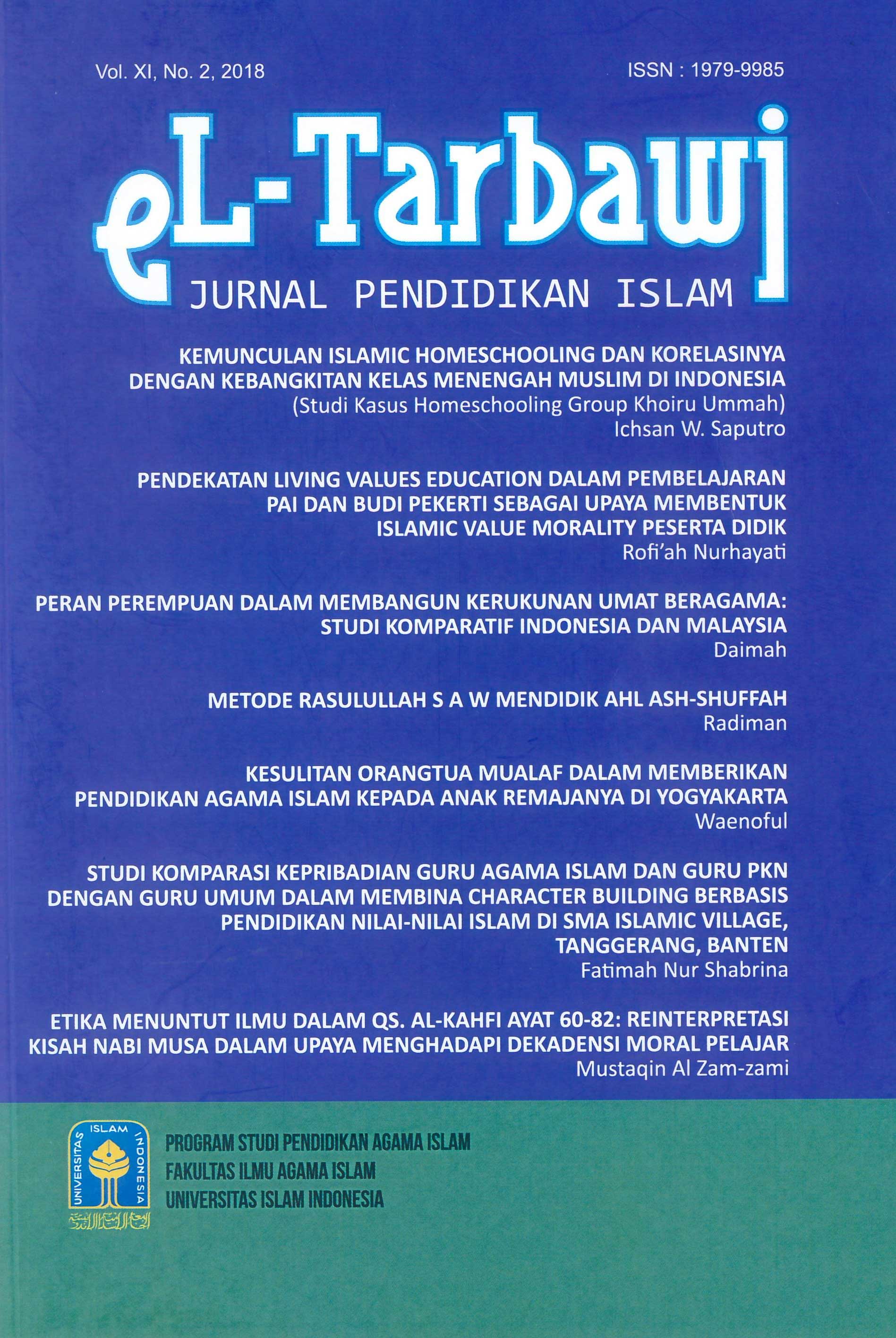Main Article Content
Abstract
This study aims to find out the method of the Prophet Muhammad educated Ahl al-Shuffah and the relevance of the method of the Prophet Muhammad to educate Ahl al-Shuffah with current Islamic education. The research method used is descriptive qualitative research design that aims to describe and to summarize various conditions, various situations, or various phenomena of social reality which exist in the community as the object of research. Analysis the data obtained in this study uses the Content Analysis strategy as a method of analyzing text and language. The results show that the method of the Prophet Muhammad in educating Ahl al-Shuffah included the method of giving advice, motivation methods, Intimidation methods, exemplary methods, discussion methods, persuasion methods, court methods, blessing methods, memorization, mulazamah, and game method. Then, this method shows the relevance that is closely related to the development of general education and Islamic education, especially at the present time
Keywords: Ash-Shuffah, Islamic Education, Method
Article Details
Authors retain copyright and grant the journal right of first publication with the work simultaneously licensed under a Creative Commons Attribution (CC-BY-SA) 4.0 License that allows others to share the work with an acknowledgment of the work’s authorship and initial publication in this journal.
References
- ---. (1425H/2004H). Al-Mu’jam al Wasith ( Cetakan ke-4).Mesir:Maktabah al-Syuruq al-Dauliyah
- ---. (2009). Software Kitab Sembilan Imam Hadits. Indonesia:Lidwa Pusaka
- ---. (2016). Software QDA Miner versi 5.0.2. --:Provalis Research
- ---.t.t. Software Gawami’ Kalim Ver 4.5. --:Islam web
- Al-Asfahani. Abi Nu’aim Ahmad bin ‘Abdullah. (1416H/1996M). Hilyat al-Auliya wa
- Thabaqat al-Ashfiya (Jilid1-2). Beirut:Dar al-Fikr
- al-Bukhari, Abu ‘Abdullah Muhammad ibn Isma’il. (1422H). Al-Jami ash-Shahih. Beirut: Dar ath-Tahuq an-Najah
- al-’Umariy, Ikram Dhiya. (1403 H-1983M). Al-Mujtama’ al-Madani fi ‘Ahdi An- Nabawiyah : Khasa'isuhu wa tandzimatuhu al-ula. Madinah. Al-Jami'ah al-Islamiyah bi al-Madinah
- Aly, Hery Noer.(1999). Ilmu Pendidikan Islam. Jakarta:Logos
- At-Turmusy, Muhammad Mahfudz bin ‘Abdillah (1324 H), Manhaj Dzawi an-Nadhar fi Mandzumati ‘Ilm al-Atsar. Riyadh:--
- Bukhari, Imam, Shahih Bukhari , Semarang, Toha Putra.
- Bukhari, Imam. (1400 H). Al-Jami’ Ash-Shahih. Kairo: Al-Maktabah As-Salafiyah
- Bungin, Burhan.(2007). Penelitian Kualitatif: Komunikasi, Ekonomi, Kebijakan Publik, dan Ilmu Sosial Lainnya. Jakarta:Kencana
- Daradjat, Zakiah., versi software dan versi cetak nomor et al.}. (1996). Ilmu Pendidikan Islam. Jakarta:Bumi Aksara
- HAMKA,--. (1940). Tasauf Modern. Djakarta:Djajamurni
- Ibn al-Atsir. Majid ad-Din Abi As-Sa’adat al-Mubarak bin Muhammad al-Jazari. (--). An- Nihayah fi Garib al-Hadits wa al-Atsar. Riyadh: Al-Maktabah al-Islamiyah
- Itr, Nuruddin. (1979). Manhaj an-Naqd fi ‘Ulum al-Hadits. Damsyiq: Daar Al-Fikr
- Jalal, Abdul Fattah. (1988). Azas-azas Pendidikan Islam (Penerjemah Herry Noer Ali). Bandung:cv.Diponegoro
- Langgulung, H. (1987). Asas-asas Pendidikan Islam. Jakarta, Indonesia: Pustaka Al-Husna
- Nata, Abudin. (2011). Sejarah Pendidikan islam. Jakarta:Kencana
- Quthb, Muhammad.(1993). Sistem Pendidikan Islam (terjemahan Drs. Salman Harun). Bandung:PT. Alma’arif
- Rahman, Fatchur. (1991). Ikhtisar Mushthalahul Hadits. Bandung:PT. Alma’arif
- Sukmadinata, Nana Syaodih. (2014). Pengembangan Kurikulum:Teori dan Praktek. Bandung:PT. Remaja Rosdakarya
- Tafsir, Ahmad. (2013). Ilmu Pendidikan Islam. Bandung:Penerbit Rosdakarya
- Winsick, A. Y. (1936). Al-Mu’jam al-Mufahras li alfadzi al-Hadits an-Nabawi. Leden: Maktabah Brail
References
---. (1425H/2004H). Al-Mu’jam al Wasith ( Cetakan ke-4).Mesir:Maktabah al-Syuruq al-Dauliyah
---. (2009). Software Kitab Sembilan Imam Hadits. Indonesia:Lidwa Pusaka
---. (2016). Software QDA Miner versi 5.0.2. --:Provalis Research
---.t.t. Software Gawami’ Kalim Ver 4.5. --:Islam web
Al-Asfahani. Abi Nu’aim Ahmad bin ‘Abdullah. (1416H/1996M). Hilyat al-Auliya wa
Thabaqat al-Ashfiya (Jilid1-2). Beirut:Dar al-Fikr
al-Bukhari, Abu ‘Abdullah Muhammad ibn Isma’il. (1422H). Al-Jami ash-Shahih. Beirut: Dar ath-Tahuq an-Najah
al-’Umariy, Ikram Dhiya. (1403 H-1983M). Al-Mujtama’ al-Madani fi ‘Ahdi An- Nabawiyah : Khasa'isuhu wa tandzimatuhu al-ula. Madinah. Al-Jami'ah al-Islamiyah bi al-Madinah
Aly, Hery Noer.(1999). Ilmu Pendidikan Islam. Jakarta:Logos
At-Turmusy, Muhammad Mahfudz bin ‘Abdillah (1324 H), Manhaj Dzawi an-Nadhar fi Mandzumati ‘Ilm al-Atsar. Riyadh:--
Bukhari, Imam, Shahih Bukhari , Semarang, Toha Putra.
Bukhari, Imam. (1400 H). Al-Jami’ Ash-Shahih. Kairo: Al-Maktabah As-Salafiyah
Bungin, Burhan.(2007). Penelitian Kualitatif: Komunikasi, Ekonomi, Kebijakan Publik, dan Ilmu Sosial Lainnya. Jakarta:Kencana
Daradjat, Zakiah., versi software dan versi cetak nomor et al.}. (1996). Ilmu Pendidikan Islam. Jakarta:Bumi Aksara
HAMKA,--. (1940). Tasauf Modern. Djakarta:Djajamurni
Ibn al-Atsir. Majid ad-Din Abi As-Sa’adat al-Mubarak bin Muhammad al-Jazari. (--). An- Nihayah fi Garib al-Hadits wa al-Atsar. Riyadh: Al-Maktabah al-Islamiyah
Itr, Nuruddin. (1979). Manhaj an-Naqd fi ‘Ulum al-Hadits. Damsyiq: Daar Al-Fikr
Jalal, Abdul Fattah. (1988). Azas-azas Pendidikan Islam (Penerjemah Herry Noer Ali). Bandung:cv.Diponegoro
Langgulung, H. (1987). Asas-asas Pendidikan Islam. Jakarta, Indonesia: Pustaka Al-Husna
Nata, Abudin. (2011). Sejarah Pendidikan islam. Jakarta:Kencana
Quthb, Muhammad.(1993). Sistem Pendidikan Islam (terjemahan Drs. Salman Harun). Bandung:PT. Alma’arif
Rahman, Fatchur. (1991). Ikhtisar Mushthalahul Hadits. Bandung:PT. Alma’arif
Sukmadinata, Nana Syaodih. (2014). Pengembangan Kurikulum:Teori dan Praktek. Bandung:PT. Remaja Rosdakarya
Tafsir, Ahmad. (2013). Ilmu Pendidikan Islam. Bandung:Penerbit Rosdakarya
Winsick, A. Y. (1936). Al-Mu’jam al-Mufahras li alfadzi al-Hadits an-Nabawi. Leden: Maktabah Brail
